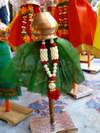 Gudhi Padwa 2011 is on 4th April. As per the Hindu lunar calendar, the New Year begins on Chaitra Shuddha Pratipada and it is this day which signifies the start of the New Year for followers of the Hindu faith. This day is named Gudhi Padwa in Maharashtra and Ugadi in Karnataka and Andhra Pradesh. The Hindu God Lord Brahma is said to have created the universe on this day.
Gudhi Padwa 2011 is on 4th April. As per the Hindu lunar calendar, the New Year begins on Chaitra Shuddha Pratipada and it is this day which signifies the start of the New Year for followers of the Hindu faith. This day is named Gudhi Padwa in Maharashtra and Ugadi in Karnataka and Andhra Pradesh. The Hindu God Lord Brahma is said to have created the universe on this day.The word padwa originates from the word pratipada, which is the 1st day of a lunar month or the 1st day after the new moon day (known as Amavasya).
Significance and Features of the Gudhi
The ‘Gudhi’ is the flag of Lord Brahma. It consists of a bamboo stick, at the tip of which a yellow or green cloth is tied. This cloth should have a zari (brocade) border. Over this cloth is tied a few twigs of neem leaves and mango leaves, a garland of red flowers (red is an auspicious colour) as well as pieces of gaohi (sugar crystals). Finally, a copper or silver pot is place in an inverted position at the very top of the gudhi. The Gudhi is always placed on the right side of the home’s entrance and is placed in such a way that it is slightly tilted.
For more information read:
How to make a simple Gudi at home and Gudi Padwa puja rituals
 |
| Gudhis |
Traditionally, before placing the Gudhi, a rangoli of the Swastik sign is created on the ground & haldi-kumkum (turmeric & vermillion powders) are put at the center of the Swastik. The doorway is decorated with a toran (bunting) of mango leaves and red or gold flowers.The Gudhi is said to bring prosperity to the home and keep out ill luck and evil.
{Note: the photos shown here are of readymade Gudhis sold in shops and by roadside vendors for prices ranging from Rs.50/- to over Rs.100/- ~~ not quite the real thing!}
Rituals of Gudhi Padwas Festival of India
It is traditionally believed that during sunrise the consciousness of the Lord can be absorbed by the body to the maximum and thereby lasts far longer than at any other time of the day. Hence, many believe that the Gudhi should be raised and worshipped within the first ten minutes of the sunrise. Before worshipping the Gudhi, though, one must take an oil bath with warm water. After saying the prayers and worshipping the Gudhi, a prasad (holy offering) is made from the paste of neem leaves, soaked dal, a bit of honey or jaggery and cumin seeds. In Maharashtra, the traditional sweet dish called shrikhand is served with hot pooris.
Gudi Padwa is considered an auspicious day to buy a new home, gold jewellery, any new appliance for the home – in general, something totally new. A new business, inauguration of a new shop or business establishment is also done on this day.
Happy New Year!

No comments:
Post a Comment